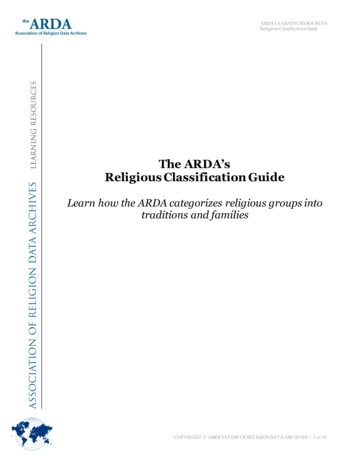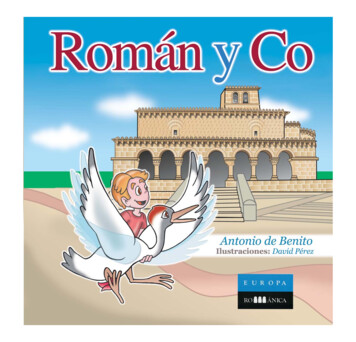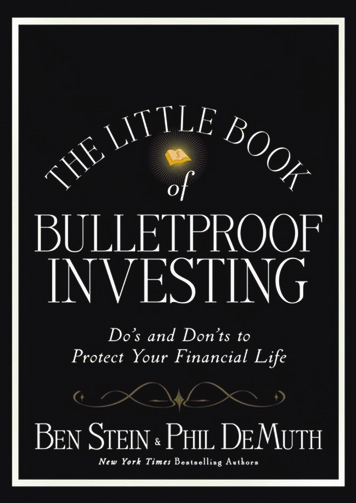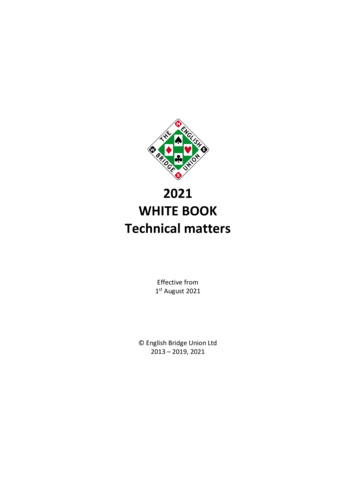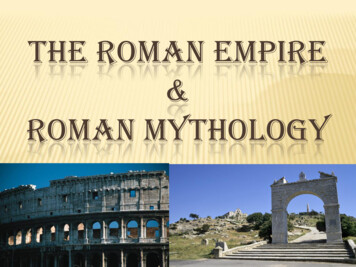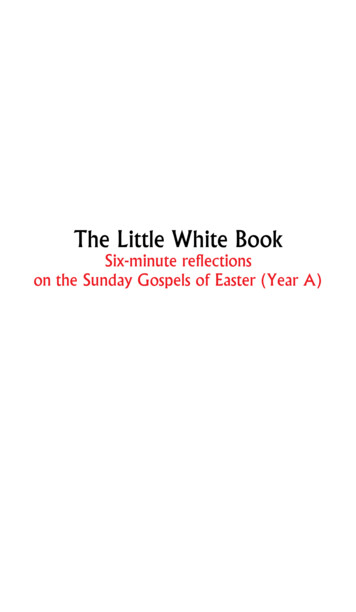
Transcription
The Little White BookSix-minute reflectionson the Sunday Gospels of Easter (Year A)
This book is dedicated toBishop Ken Untener(1937-2004)who was inspired to createthe Little Books. His life and faithcontinue to be their driving force.This Easter booklet is based on the writings of BishopKen Untener, and put together by Catherine Haven, editorof the Little Books, with the help of Sr. Nancy Ayotte, IHM,who works with the Catechesis of the Good Shepherd.Distribution is under the direction of Leona Jones. 2019 Diocese of Saginaw.For additional books, contact:Little Books of the Diocese of Saginaw, Inc.P.O. Box 6009, Saginaw, MI 48608-6009(989) 797-6653FAX (989) 797-6606or visit our web site atwww.littlebooks.org
How to Usethe Little White BookThis Little White Book is meant to help you enjoy sixminutes a day in prayer during these next 50 days of theEaster season.The key is the right-hand page. On that page each day(except Sundays), we’ll walk through the Sunday Gospelsof Cycle A (this year’s liturgical cycle).The left-hand page is like a buffet table with information about the Easter season, or various traditions and customs, or the saint whose feast is celebrated on that particularday. This year, on Sundays and periodically throughout theweek, we’ll focus on the 12 apostles.Start with either page, as you wish.The main thing is to spend some quiet time with theLord using one of our oldest traditions of prayer calledlectio divina – sacred reading. We take a short Scripturepassage and simply let God speak to us through the words,guiding us to reflections that sometimes seem to come fromnowhere. But they’re not “from nowhere.” They’re fromGod.People are often surprised at how easy it is to pray thisway, and how deep such prayer can be.On Monday, April 13, we’ll begin walkingthrough Sunday’s Gospel reading.
April 13, 2020Easter seasonRecords show that Christians, besides celebratingEaster Sunday, celebrated a continuing Easter season as farback as the beginning of the third century.Outside of Ordinary Time, it became the Church’s longestseason – a 50-day stretch from Easter Sunday to Pentecost Sunday. It was not a time for penitential practices. Fasting and kneeling were not permitted. It was a time to exult in God’s goodness.Why is the Easter season so long?Because Christians believed that the Resurrection wasjust too big and too important to be celebrated for only oneday, or even one week.Why 50 days . . . not 10, or 20?Because there was already in place a Jewish feast called“Pentecost” (a harvest festival) which took place 50 days after Passover. When Pentecost became a Christian feast celebrating the descent of the Spirit, Christians turned the timebetween Passover and Pentecost into the “Easter season.”The symbol of the Easter season isthe paschal candle. Consider havinga special candle in your home to lightduring these 50 days. Symbols help.
Monday, First Week of EasterAfter the Sabbath, as the first day of the weekwas dawning, Mary Magdalene and the otherMary came to see the tomb. And behold, therewas a great earthquake; for an angel of the Lorddescended from heaven, approached, rolled backthe stone, and sat upon it. (Mt 28:1-2)At times like Easter there is something within me thatwants to be hopeful. Yet I may be afraid to let it out, particularly when I have seen so many hopes dashed.Hope is a tender feeling, easily bruised. When youhope, you are vulnerable. You can make a fool of yourselfespecially when your hopes do not turn out. When the pessimist turns out to be right, then you appear foolish, naive.To have hoped and lost often makes us more guarded.In the Bible, even those who suffer are able to hopebecause their hope is based upon what God can do, not whatthey can do.Perhaps this Easter season, I should allow myself tohope. There is the reality of Good Friday which means that Iaccept the fact of suffering and failure.But Easter is also a reality – it shows what God can doand it offers me hope no matter the situation.Spend some quiet timewith the Lord
April 14, 2020Who were the 12 apostles?Luke names the apostles as Peter, John, James, Andrew,Philip, Thomas, Bartholomew, Matthew, James (son of Alphaeus), Simon the Zealot, and Judas (son of James). Matthias would later join this group to replace Judas Iscariot,the betrayer of Jesus.John’s Gospel refers to 12 apostles but only givesnames for nine of them: Peter, Andrew (identified as Peter’sbrother), the sons of Zebedee (plural form implies at leasttwo apostles), Philip, Nathanael, Thomas (also called Didymus), Judas Iscariot, and Judas (not Iscariot).Matthew and Mark’s list of the 12 apostles agrees withLuke’s for the most part. But they substitute Thaddeus forJudas, son of James (the saint normally referred to as St.Jude Thaddeus).Why do the apostles’ names differ on the evangelists’lists? In some cases, it wasn’t unusual for a person to beknown by two different names. Peter, for example, is alsoknown as Simon. Possibly Judas, the son of James, preferred to be called Thaddeus so that he wouldn’t be confused with Judas Isacriot.
Tuesday, First Week of EasterThe angel’s appearance was like lightning andhis clothing was white as snow. The guards wereshaken with fear of the angel and became likedead men. (Mt 28:3-4)The cross has become a victory sign.If God can bring meaning even to the cross, then Godcan bring meaning to anything. Only God could transformsuffering and failure into victory.This is the joy of Easter.We all have parts of our lives that seem so useless, sosenseless, so meaningless.Some of my failures I bring on myself. Some of themare not my own doing, I can’t control what happens.Some are small pockets of our life – irritations andfrustrations.Some are major concerns.Easter celebrates God’s ability to bring meaning to anyaspect of human life, even something apparently useless,even a total failure.Easter celebrates the fact that God’s capacity for goodness is greater than my capacity for failure.Now that’s something to celebrate.Spend some quiet timewith the Lord
April 15, 2020Fire at Notre Dame CathedralOne year ago today, a major electrical fire damaged thecenturies-old Notre Dame Cathedral in Paris, France.Many of the cathedral’s priceless artifacts were rescuedduring the blaze when bystanders formed a human chain toretrieve art and religious artifacts. Among the items saved wasa reliquary (a repository for relics) containing Jesus’ crown ofthorns, and a 13th-century tunic said to belong to St. Louis.Some of the 850-year-old cathedral’s valuable artwas undamaged because it had been removed a few daysbefore the fire. As part of Notre Dame’s multi-million dollarrenovation that was underway, the art pieces had been takenfrom the cathedral for cleaning and repair due to damagefrom time and pollution. Among the saved art were sculptures of the 12 apostles and the four evangelists.The sculptures of the apostles each weigh about 500pounds. They were installed at Notre Dame in 1859 and1860 during an earlier major reconstruction of the cathedralby a 30-year-old Gothic-Revival architect named EugeneViollet-le-Duc. He faced a daunting task. During the FrenchRevolution, the cathedral’s statues had been destroyed, andits bells melted down into cannons. After years of neglect,the cathedral also needed a new spire.Viollet-le-Duc is said to be the model for the statue ofSt. Thomas the Apostle.
Wednesday, First Week of EasterThen the angel said to the women in reply,“Do not be afraid! I know that you are seekingJesus the crucified. He is not here, for he has beenraised just as he said. Come and see the placewhere he lay.” (Mt 28:5-6)There is greatness and grandeur in the universe, andthere is so much about it that I don’t know. Perhaps theearth and the sun and the planets are just like tiny atoms insome molecule . . . and the molecule is part of something somuch larger and different than the universe that I can’t evenimagine it.It could be so. I really don’t know.Some physicists talk about matter and anti-matter, sothat for every atom that exists here, there is an unseen mirror of it on the other side that we cannot get into contactwith . . . and from this they posit the possibility of a wholeother universe.But Scripture doesn’t give a detailed map of theuniverse. Scripture gives insights. It doesn’t tell how bigthe universe is, only that God made it all. Jesus didn’t giveall the details of a structured cosmos. He taught that it allbelongs to God, and that each of us is loved, protected andcherished.I walk by faith and not by sight. If I follow these insights, whatever the shape of this vast cosmos, I walk downright paths and need never fear.Do not be afraid. That’s good advice.Spend some quiet timewith the Lord
April 16, 2020Patron saint of coffeehousesToday is the feast of St. Drogo, the patron saint of coffeehouses.Drogo was born in 1105 in what is today known asFlanders, an area of southern Belgium near the French border. He was orphaned as an infant, and later blamed himselffor the fact that his mother had died giving birth to him.Although his parents had left him with a comfortable lifestyle, Drogo chose to live a simple life. He gaveaway much of his inheritance, and worked as a shepherd inSebourg, France. After several years, he sensed a call fromGod to become a pilgrim, and traveled to religious sitesthroughout France and Italy, including the tombs of SS.Peter and Paul in Rome.When illness made him physically unattractive, he livedas a hermit in Sebourg where he built a small room attachedto the parish church. He died on this day in 1186 (or 1189),and is the patron saint of shepherds.No one knows why this ascetic saint is also the patronsaint of coffeehouses. Perhaps it was because Drogo wouldonly drink warm water.
Thursday, First Week of EasterThe angel said, “Then go quickly and tell hisdisciples, ‘Jesus has been raised from the dead,and he is going before you to Galilee; there youwill see him.’ Behold, I have told you.” (Mt 28:7)Sometimes today, it is hard to have hope.A recent survey indicated that most people are unwilling to place their hope and trust in anything.We protect hope carefully, especially when it comes tothe most important things in life.We don’t want our hopes to be bruised . . . or completely crushed.I might watch television and hope that a certain gameshow contestant wins the big prize or hope that my teamwins the game. But that is hope from a safe distance.But when it comes to the crucial things in my life andthe lives of those I love, I can sometimes be reluctant tohope.The message of Easter speaks directly to this. Jesus tellsme that it is safe to hope. Do not be afraid. Jesus has methead-on the things I may fear the most – suffering, failure,sin, death – and he has beaten them all.It is safe to hope.Spend some quiet timewith the Lord
April 17, 2020Easter IslandOn April 5, 1722, Dutch explorer Jacob Roggeveencame upon an isolated island west of Chile in the southPacific Ocean. Because it was Easter Sunday, he named hisdiscovery Easter Island.French missionaries arrived at EasterIsland in the 1860s. On January 2, 1864,Brother Eugène Eyraud (1820-August 23,1868), a member of the Congregation ofthe Sacred Hearts of Jesus and Mary, wasthe first foreign missionary to live on theisland. He had used his own money to sailfrom Tahiti to Easter Island. The bishop ofTahiti, Florentin-Etienne Jaussen (April 12,1815-September 9, 1891) is credited with introducing theisland’s language to the world. He also ended slave raidson Easter Island, and ordained the first Eastern Polynesianpriest in 1874.Today, about 2,500 people live on the island, which isnoted for its large rock carvings along the coastline. Theonly Catholic church on the island is Holy Cross Church,which was founded in 1937 by a German Capuchin friar, Fr.Sebastian Englert.Fr. Englert served as a missionary on the island formore than 30 years, and often incorporated the native language of Rapa Nui into the liturgy.***Norwegian explorer Thor Heyerdahl visited the island inthe 1950s and in the 1980s, and purchased thousands of artifacts which he took back to Norway. In 2019, the Norwegiangovernment agreed to return his collection to Easter Island.
Friday, First Week of EasterThen they went away quickly from the tomb,fearful yet overjoyed, and ran to announce this tohis disciples. (Mt 28:8)Jesus has risen, and what he promised has come true.Even in the face of the power of the Roman governor,even in the face of the ugly, senseless death on the cross – Jesushas promised I can overcome evil by responding with love.Even in the face of all the sad and terrible things thatcan go on in life – broken relationships, lost jobs, addictions, sickness – Jesus has promised that I can overcomeevil by responding with goodness.Sometimes it’s awfully hard to believe in that promise.Maybe it would be easier to accept if I could see the promisework out on a large scale. If the factions in Iraq or Afghanistan came together and made peace, it would make headlinesand we’d say the world is now a better place. I might believein the promise if responding to violence and hatred withlove led to peace in a large-scale situation like that. Maybe.But with the small-scale stuff – responding with loveto the family jealousies and petty problems that go on everyday in my life, responding with patience and prayer justdoesn’t seem like it can have much effect.But at the time, the crucifixion of Jesus was small-scalestuff. It was nothing on the world scale. It was nothing onthe scale of Israel. It wasn’t even a big event in Jerusalem.One person getting killed in that city didn’t bring anythingto a stop. But look what Jesus did, what he said. He responded with goodness and love, and it made this worldsomething that it had never been before.Perhaps I need to try responding to my problems withgoodness and love – the way he did.Spend some quiet timewith the Lord
April 18, 2020Thomas,‘the Outspoken Twin’Thomas the Apostle is mentioned several times inJohn’s Gospel. Although he is best known as the “doubtingThomas,” he also comes across as a person of courage whospeaks his mind.At one point, some Jewish people in Jerusalem threatened to stone Jesus because he had said, “The Father andI are one.” Jesus left the city and went to a deserted placewith his disciples. While there, he heard that his friendLazarus had died. Jesus tells the disciples that he is goingback to the Jerusalem area to “awaken” Lazarus. They warnJesus that a return there so quickly would be dangerous.Thomas says, “Let us also go to die with him.”***The feast of St. Thomas at Kurisumudy is held in Malayattoor, India, each year on the Sunday after Easter. It celebratesthe proclamation of Thomas the Apostle that Jesus was God.(This Gospel is always read on the second Sunday of Easter.)Thomas holds special meaning for Malayattoor. Tradition says, after the resurrection of Jesus, Thomas came toIndia aboard a Roman ship with a group of spice merchantsin 52 A.D. and then traveled to this village. He spent 20years in India where he founded seven Christian communities. While he was in Malayattoor, Thomas’ life was threatened and he fled to the top of Kurisumudy mountain wherehe spent many days in prayer.The feast of St. Thomas in the universal Church is July 3.
Saturday, First Week of EasterAnd behold, Jesus met the women on their wayand greeted them. They approached, embracedhis feet, and did him homage. Then Jesus said tothem, “Do not be afraid. Go tell my brothers to goto Galilee, and there they will see me.” (Mt 28:9-10)The disciples had heard Jesus speak for a couple ofyears about the way to fulfillment. They heard him say thatthe way things work out best, the way to life, is to entrusteverything to God. They heard him say that they weredaughters and sons of God, and they were to act like Godacts, responding to evil with goodness, turning the othercheek, being gentle and truthful.They had seen it work in situations in Jesus’ own hometown when people got stirred up against him. He never, everdrew a sword, he was always forgiving and gentle . . . and itworked.When Jesus was arrested, and Judas and others came athim with swords and clubs, the disciples must have been terrified and probably thought, “Jesus’ way doesn’t work.” They allabandoned him, not to be heard from again until after his death.Now, on Easter Sunday, they get the news that the tombwas empty. Perhaps they began to think, “Could it be . . .that trusting in God works, even in the face of the power ofthe Roman governor, even in the face of the ugly, senselessdeath on the cross? Could it be that the way of life Jesustaught us works even against death?”That’s the good news we celebrate on Easter.Trust God.It works.Spend some quiet timewith the Lord
April 19, 2020Orthodox liturgical colorsToday is Orthodox Easter.There are four liturgical colors in the Roman CatholicChurch: green (Ordinary Time), red (martyrs and Pentecost), purple (Advent and Lent), and white (Easter).But in the Orthodox Church, liturgical colors are different: white (Resurrection), red (Advent season and feasts ofmartyrs), purple (Lent), blue (feasts of the Blessed Mother).On the feast of Pentecost, the liturgical color is green tosymbolize that God gives life to all creation, as a life-givingSpirit.Today is Divine Mercy Sunday.
Second Sunday of EasterWhat it meansto be a discipleThe Gospels were preached long before they were written, and Peter would have heard the story of his repeateddenial of Jesus.I wonder how he felt? Imagine him sitting there whenit was one of the other apostles’ turn to preach, and he hearsthe apostle say: “Whoever disowns me before men, I willdisown before my Father in heaven.”I wonder how the other disciples felt? Every single oneof them fled when Jesus was arrested. They must have heardthis preached too, and they must have felt bad.Probably Peter would have stood up for Jesus had hebeen hauled before the magistrate (rather than before a maidservant in the courtyard) and called upon to accept or rejectChrist publicly. Probably I would do the same if I were calledup before some pagan tribunal to accept or reject Christ. Itwould be difficult, but the adrenalin would flow, and I wouldsummon up all my spiritual strength, and I could do it.But the problem is in the courtyards of my life whereI am often called upon, or at least given the opportunity, tosay whether or not I am a follower of Christ. The people arejust ordinary people who want to know what kind of life Ireally live. And lots of times I may hedge in my response.It’s not a question of whether or not I believe in God.It’s whether or not I am a follower of Jesus, much as themaid servant asked Peter. People want to know what valuesystem I follow in my life.Jesus said: “Do not let them intimidate you. What I tellyou in darkness, speak in light. What you hear in private,proclaim from the housetops.”Something to think about.
April 20, 2020‘I attended Mass there long agoand prayed until I got my first job.’– Gregory PeckActor’s ChapelSt. Malachy Church in New York City is known for itsActors’ Chapel.The parish was founded in 1902 by Archbishop JohnFarley (who was born on this day in 1842). Because of itsproximity to Broadway’s theatre district, Catholic actors,musicians, dancers, and other show business people becamepart of St. Malachy’s congregation. Masses, confessionsand missions were arranged to accommodate their theatreschedules.By the 1930s, St. Malachy’s parishioners included suchCatholic actors as Spencer Tracy, Irene Dunne, and RosalindRussell. Rudolph Valentino’s funeral Mass was held at St. Malachy’s in 1926. Douglas Fairbanks Jr. married Joan Crawfordthere in 1929. Bing Crosby’s movie, “Going My Way,” wasfilmed at St. Malachy’s in 1944. George M. Cohen donated analtar railing for the church, and, over the years, altar serversincluded Don Ameche, Jimmy Durante, and Pat O’Brien.Despite its star-studded history, St. Malachy’s facedclosure many times in later years due to finances, a declining parish membership, and a changing neighborhood thatsoon became unsafe.Fr. George W. Moore is credited with infusing newlife into St. Malachy’s after he became its pastor in 1976.He established a residence for elderly homeless people, andworked with folks with AIDS. He died at age 64 on May3, 1991, three days before it was announced that he wasto receive a special Tony award for his commitment to thepoor and elderly.
Monday, Second Week of EasterOn the evening of that first day of the week,when the doors were locked, where the discipleswere, for fear of the Jews, Jesus came and stood intheir midst and said to them, “Peace be with you.”(Jn 20:19)In this week’s Gospel meditation, the main theme is belief – Jesus urges Thomas to be believing, not unbelieving,and the author of John’s Gospel also urges us to believe.For many years now, Catholics have been drifting awayfrom regular Mass attendance. People speculate on the reasons for this and there is probably a combination of reasons.But one possibility is: some people do not come to Massbecause they don’t believe any more, or at least becausetheir belief has weakened.For a long time, people took faith for granted. We assumed that we all believed in God, and Jesus Christ, and lifeafter death. We spent our time talking about what we do asCatholics, not what we believe. It may be harder to believetoday because society does not support Christian faith – itnot only challenges what we do but also what we believe.Faith is a gift of God, but it takes personal courage andconviction in order to believe. You have to take a risk. Youhave to think about faith and reflect on it.You have to be attentive to your faith and you mayhave to wrestle with it.I need to take a hard look at my faith, because I can’ttake it for granted.Spend some quiet timewith the Lord
April 21, 2020‘To be a Catholic doesn’t mean to be an imbecile.’– Mary McGroryMary McGroryBorn in Boston, Massachusetts, in 1918, Mary McGrory was a columnist for the Washington Star, and laterthe Washington Post. Her column was syndicated to 187newspapers, and in 1975, she became the first woman to winthe Pulitzer Prize for commentary.McGrory was also a devout Catholic. She gave 20percent of her income to charity, especially to a home forunwed mothers and their children, St. Ann’s Infant and Maternity House in Washington, D.C. She volunteered weeklyat St. Ann’s, paid children’s tuition, and wrote checks tocover the orphanage’s costs.She attended Mass daily, and her biographer notes thatshe kept a copy of Thomas a Kempis’ “Imitation of Christ”on her nightstand. She also identified with liberation theology, believing that the Catholic Church didn’t measure upto its responsibility to oppressed people. McGrory was aregular contributor to America magazine.Mary McGrory died on this day in 2004. Her funeralMass was celebrated at the Shrine of the Most Blessed Sacrament in Washington, D.C.
Tuesday, Second Week of EasterWhen Jesus had said this, he showed the disciples his hands and his side. The disciples rejoicedwhen they saw the Lord. Jesus said to them again,“Peace be with you. As the Father has sent me, soI send you.” (Jn 20:20-21)The 20th chapter of John’s Gospel contains four episodes of faith: Mary Magdalen discovers the empty tomb and runs totell the disciples. Peter and the beloved disciple run to thetomb and see and believe. This is the first recorded act offaith in the risen Jesus. Mary Magdalen meets Jesus at the tomb. He calls herby name and she believes in him. Jesus appears to the disciples in the Upper Room.They see and believe. A week later Thomas is with the disciples when Jesusappears and he expresses explicitly: “My Lord and my God.”Why does the author of this Gospel focus so intenselyon the theme of faith in the risen Christ?This “Easter faith” is so important because it givescolor and meaning to life and to death, even to suffering.When I have faith in Christ who is risen from the dead, I amno longer dealing with a flat, dull world. Faith is luminouswith the presence of God, and holds the promise of a destinyin God’s hands. Faith brings life and verve to my existence,even when nothing else seems to make sense.I should think about that. It could change how I look atthe world . . . and my place in it.Spend some quiet timewith the Lord
April 22, 2020Matthew the ApostleMatthew was a tax collector in Capernaum when Jesuscalled him to be a disciple. Mark and Luke call him Levi.Little is known about his life in the earlyChurch. Tradition says he preached inEthiopia, Parthia (modern-day Iran) andPersia, and that he was beheaded for hisfaith. His feast is September 21, and he isthe patron saint of accountants.***Is Matthew the Apostle also Matthew the Evangelist?Early Christian tradition attached Matthew’s name towhat is now known as the “Gospel of Matthew.” However,since this Gospel appears to have been written sometime after 80 A.D., and uses a great deal of material from an earlierGospel (that of Mark), biblical scholars think it unlikely thatthe author was an eyewitness of the events narrated.Toward the end of the first century, there was a tendency to attach the names of deceased apostles to variouswritings, because these writings preserved the apostolictradition. It may be that the name of the apostle Matthewwas given to this Gospel because it was written by someonewho was part of an early Christian community evangelizedby Matthew himself.***The Sunday Gospel readings during Cycle A (which areused this year) are generally taken from the Gospel of Matthew, especially during Ordinary Time.
Wednesday, Second Week of EasterWhen Jesus had said this, he breathed onthe disciples and said to them, “Receive the holySpirit.” Jesus said to the disciples: “Whose sinsyou forgive are forgiven them, and whose sins youretain are retained.” (Jn 20:22-23)It is Easter Sunday evening, about 48 hours after Jesus’death on the cross.During the passion and death of Jesus, the discipleswere not the world’s finest disciples. Peter denied Jesusthree times. The rest of them (except, in John’s account, thebeloved disciple) were noticeably absent from the momenthe was arrested.But notice Jesus’ first words to them 48 hours later –not, “Where were you?” or “How could you have done sucha thing?” or “I am so disappointed in you.”Look again at his first words: “Peace be with you.”Then he starts talking about forgiveness, a welcomeword to those disciples who needed forgiveness.I can almost feel the sense of relief that must have comeover them.We’re all sinners, and down deep we know it. Andthe Lord always approaches us with words of peace andforgiveness.Maybe I need to thank the Lord for this great kindnessto me.Spend some quiet timewith the Lord
April 23, 2020DidymusThomas apparently had a nickname – “Didymus” (theGreek word for “twin”). There is an interesting traditionthat the disciples gave Thomas this nickname because, inappearance, he closely resembled Jesus. They would refer tohim, not as “Thomas,” but as “The Twin.”Apocryphal Gospels have also said that Thomas wasthe twin brother of Matthew or even of Jesus himself.While Thomas might have indeed been the twin brotherof someone, the Church has never believed that it was Jesus.
Thursday, Second Week of EasterThomas, called Didymus, one of the Twelve,was not with them when Jesus came. So the disciplessaid to him, “We have seen the Lord.” But he said tothem, “Unless I see the mark of the nails in his handsand put my finger into the nail marks and put myhand into his side, I will not believe.” (Jn 20:24-25)It doesn’t seem fair.The other disciples had a visual experience of the risenLord. He appeared to them in the Upper Room. Thomas(perhaps through no fault of his own) missed out. But therest of the disciples expect Thomas to believe in the Resurrection just as much as they do.It’s not fair . . . and Thomas tells them that in so manywords. He says in effect, “Look. You say you saw Jesus.Fine. But I didn’t see him and I’m not going to take this onhearsay! I want to see, just like you did.”Perhaps the disciples argued with him and told him thatwhat they saw was real – Jesus showed them his wounds.Thomas gets a little carried away (perhaps he’s tickedoff). He says that he wants not only to see the risen Lord,but also to put his finger into the nail marks.Sometimes I might feel just as Thomas felt – it’s notfair. The appearances of the risen Lord in those first daysafter the Resurrection were miraculous, one-time specialevents that aren’t available to me.But the experience of the risen Lord truly presentwithin me, around me, and alongside me, is just as real.It’s an experience that is available to me – sometimeswhen I least expect it.Spend some quiet timewith the Lord
April 24, 2020Fra MauroIn February 1971, Apollo 14 astronauts Alan Shepherdand Edgar Mitchell collected samples of rock on the FraMauro formation, a crater on the moon.The crater was named after a 15th-century monk andcartographer who created what was called the “ultimate mapof the world.” His map included pictures of a region’s minerals, and comments about a particular geographic area.Little is known about Fra Mauro. Born about 1400, as ayoung man he traveled as a merchant and soldier throughout theMiddle East. Eventually he became a Camaldolese monk at theMonastery of St. Michael on Murano Island in Venice, Italy.As a religious, Fra Mauro had to curtail his traveling,but his interest in faraway lands never waned. He frequentlyquizzed returning travelers, sailors, missionaries, and pilgrims about places they had visited. Once his mapmakingskill became known, King Alfonso V of Portugal commissioned him to create a world map. The monk completedthe task in 1459, but the map was lost when he sent it toPortugal. Fra Mauro died the following year while makinga copy of
dead men. (Mt 28:3-4) The cross has become a victory sign. If God can bring meaning even to the cross, then God can bring meaning to anything. Only God could transform suffering and failure into victory. This is the joy of Easter. We all have parts of our lives that seem so useless, so senseless, so meaningless. Some of my failures I bring on .


